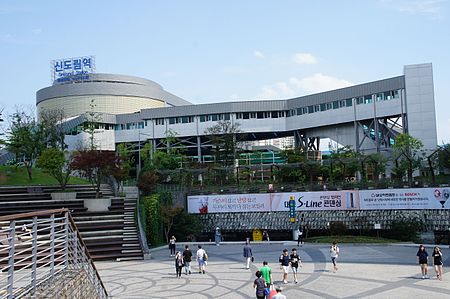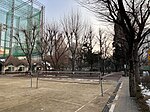Sindorim station

Sindorim station is a station on Seoul Subway Line 1 (overground platforms) and Line 2 (underground). It is also the southeastern terminus of Line 2's Sinjeong Branch to Kkachisan (underground platform 3). The station is located at the northern edge of Sindorim-dong, Guro-gu, Seoul, on the border with Yeongdeungpo-gu. Sindorim station is designed primarily to serve as a transfer station of the Subway Lines 1 and 2, having no direct exits from the Line 1 platform. It is known to be the most congested transfer station of Seoul Subway, especially during the rush hours. It is estimated that over 320,000 passengers per day use Sindorim Station to transfer between Lines 1 and 2. A plan to extend the Line 2 part of the station, including a new platform for the outer circle line, is now on design. Screen doors have been added to the subway platforms. D-Cube City, a large leisure complex consisting of a Hyundai department store, additional coffee shops & restaurants on the periphery, a Sheraton Hotel and a Lotte Cinema, is located next to the station. The complex was opened in 2011 and is directly connected to the station by an underground passageway which passes under the entire width of the station. All Line 2 trains that operate up to this station take the Sinjeong branch to be serviced at the Sinjeong train servicing depot, located next to Yangcheon-gu Office station. In 2013, improvements were made in terms of accessibility for Line 1. A new overhead concourse was constructed above the Line platforms to ease congestion in the underground concourse, where passengers transfer between Lines 1 and 2. The new overhead concourse includes childcare facilities and meeting rooms. South Korean music group Jaurim wrote in the song "The Departure," "Strip Show in Sindorim Station..."I wrote the lyrics, ".
Excerpt from the Wikipedia article Sindorim station (License: CC BY-SA 3.0, Authors, Images).Sindorim station
Gyeongin-ro, Seoul
Geographical coordinates (GPS) Address Nearby Places Show on map
Geographical coordinates (GPS)
| Latitude | Longitude |
|---|---|
| N 37.509166666667 ° | E 126.89111111111 ° |
Address
신도림역
Gyeongin-ro 688
08209 Seoul
South Korea
Open on Google Maps










